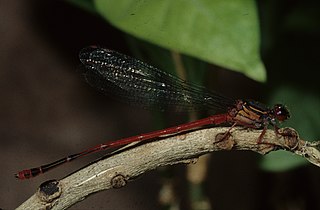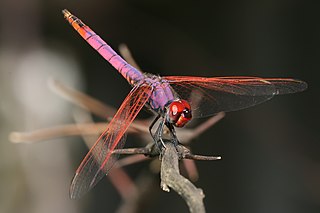
Megalagrion is a genus of damselflies in the family Coenagrionidae. It contains approximately 26 species, all of which are endemic to Hawaiʻi. Megalagrion damselflies are the only native damselflies in Hawaiʻi, and are referred to as "pinapinao" in ʻ ʻŌlelo Hawaiʻi. Other native Hawaiian dragonfly species include Anax strenuus and Nesogonia Blackburni, which are referred to as "pinao".

Orthetrum is a large genus of dragonflies in the Libellulidae family. They are commonly referred to as skimmers.
This article is a list of biological species, subspecies, and evolutionary significant units that are known to have become extinct during the Holocene, the current geologic epoch, ordered by their known or approximate date of disappearance from oldest to most recent.

Akialoa is an extinct genus of Hawaiian honeycreeper in the subfamily Carduelinae of the family Fringillidae. The ʻakialoa species are all extinct, but they formerly occurred throughout Hawaii.

Chlorocypha is a genus of damselflies in the family Chlorocyphidae.
Megalagrion adytum is a species of damselfly in the family Coenagrionidae that is endemic to Hawaii. Its natural habitat is swamps.
Megalagrion oahuense is a species of damselfly in the family Coenagrionidae. It is endemic to Hawaii. It is the only known species of odonate with terrestrial nymphs.

Megalagrion oceanicum is a species of damselfly in the family Coenagrionidae that is endemic to the island of Oʻahu in Hawaii. It inhabits rivers in the Waiʻanae and Koʻolau ranges. It is threatened by habitat loss.

The Pacific Hawaiian damselfly, Megalagrion pacificum, is a species of damselfly that is native to Hawaiian streams and wetlands at low elevations. They are predaceous and territorial narrow-winged damselflies that can be identified by their abdominal markings. In the last century, the populations of Pacific Hawaiian damselflies have decreased due to invasive species, habitat loss, climate change, stream alteration, and urban development. The species was listed as an endangered species under the Endangered Species Act on July 26, 2010.

Mesocnemis is a genus of African damselflies in the white-legged damselfly family (Platycnemididae). They are commonly known as Riverjacks.

Platycypha is a genus of African damselflies in the jewel damselfly family (Chlorocyphidae).

Trithemis is a genus of dragonflies in the family Libellulidae. They are commonly known as dropwings. There are over 40 species, mainly from Africa; two are endemic to Madagascar, and five can be found in Asia. They are found in a wide variety of habitats; some species being adapted to permanent streams in forests, and others being capable of breeding in temporary pools in deserts.

Coenagrion hastulatum, the northern damselfly or spearhead bluet, is a damselfly in the family Coenagrionidae.










